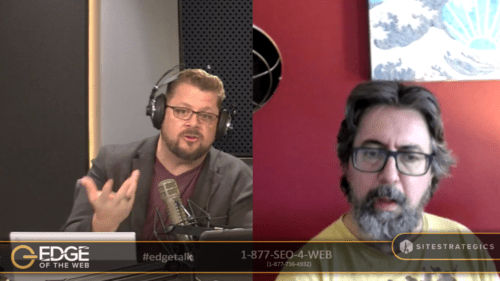Our special guest for episode 323 of the award-winning EDGE of the Web podcast was Bill Slawski, Director of SEO Research at Go Fish Digital. Site Strategics CEO Erin Sparks spoke with Bill about what’s happening in the world of SEO, and especially recent developments at Google. Here’s what we learned:
Bill Slawski: His Background and Experience
Bill Slawski is the Director of SEO Research at Go Fish Digital. He has more than 20 years of SEO experience and a law degree and is considered the foremost expert on Google’s patents as the relate to SEO. Bill is the Editor of SEO by the Sea, a prominent search engine optimization blog, where he is the author of over 1,000 posts. Bill’s experience includes Fortune 500 brands and some of the largest websites in the world. Bill is a contributing author at Moz and Search Engine Land. He’s been involved in internet marketing and web promotion since 1996.
When it comes to Google’s patents and what they mean, you won’t find someone who knows more and can explain it all than Bill Slawski. Google is good at obscuring their real intent in various patent filings, sometimes by breaking them up into multiple filings. Bill looks at the big picture and puts the pieces together to figure out what’s going on.
After college, what Bill wanted to do was practice environmental law. In law school, he was learning how to tap into online databases about natural resources and this process of finding information on the emerging internet fascinated him. When an SEO opportunity came his way, he took it and hasn’t looked back since.
The Big Picture of Digital Security
There are lots of things digital marketers do to try and stay on top of changes and developments at Google, but one channel most people don’t pay attention to is Google’s patent filings because you can bet that everything new they’re developing they’re also trying to protect with patents.
This is where Bill steps in with his expertise. There’s a lot to learn from those patent filings. And Google always has multiple things happening at the same time – they never place all their bets on just one horse. But what Bill’s expertise in Google patents is especially good for is seeing what’s coming in the future. Bill wants to get a sense of what Google will be doing in 10 years, not just what’s happening now. Google’s patents are the way Bill peeks at what’s happening behind the curtain.
Quality Visits in Local Search
Google was recently granted a patent that has to do with “quality visits” to a brick-and-mortar business location. As Google tracks where people go and spend time, then they can accumulate data that feeds into a quality visit score for a business location. Google is considering giving out digital badges to the most popular business locations to signal that they take these quality visit scores seriously. In this approach, the frequency of visits by multiple people to a business are seen as an indication of the popularity of that business. And they’re aware that different types of businesses have different visitation patterns. You can find out more about this in Bill’s blog article about quality visit scores.
Schema and Featured Snippets
Think of featured snippets as fact-based answer boxes. As Google got deeper and deeper into analyzing people’s queries, they got better at identifying when someone is asking a question to which Google could provide a fact-based answer, so a featured snippet puts the answer to the question in a special box. Google has created a vast store of questions and answers it can draw on to present featured snippets. And now Google is probably finding those answers with help of schema and other ways it can detect when a page has the answer to a question it can put in a featured snippet. But in general Google is finding featured snippet answers to questions in structured data.
Categorical Quality in Google Search Results
Another recent patent by Google has to do with categorical quality in search results. Google has always been working on deciphering the “intent” behind searches. A search with an “informational intent” means the searcher is looking for broad information on a topic. When a user has an idea that there’s a website out there with the information they want, then their search has a “navigational intent” to get to the site they know is out there.
An informational search is going to return lots of sites that have information on the topic, and there may not be a particular site more users click on, so how can Google return the best results to answer the question? And what happens when a question is vague? For example, say a user types in the question “How long is Harry Potter?” Google doesn’t know if the person is asking how long the book is, how long the movie is, how long the Harry Potter ride at an amusement park is, and so on. What Google is now trying to do is take a vague or very broad query and present results organized into different categories. And then, within those categories, calculating a page’s “category quality score” to rank the results instead of using the standard relevance (how many people click on it) and authority approaches. Then it’s a matter of figuring out how Google is going to judge categorical quality. Read more in Bill’s blog article about categorical quality.
Connect with Bill Slawski and Go Fish Digital (GFD)
Twitter: @bill_slawski (https://twitter.com/bill_slawski)
LinkedIn: https://www.linkedin.com/in/slawski
SEO by the Sea: http://www.seobythesea.com
GFD Website: https://gofishdigital.com
GFD Twitter: @GoFishDigital (https://twitter.com/gofishdigital)
GFD Facebook: @GoFishDigital (https://www.facebook.com/GoFishDigital)
GFD LinkedIn: https://www.linkedin.com/company/go-fish-digital
Is Your Digital Marketing ROI Everything it Could Be?
Take the digital marketing ROI bull by the horns with a Site Strategics report examining your SEO, content, social media, and PPC. Visit https://edgeofthewebradio.com/roi/ to get 30% off a comprehensive review of your digital assets!


